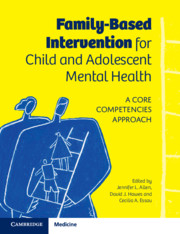Book contents
- Family-Based Intervention for Child and Adolescent Mental Health
- Family-Based Intervention for Child and Adolescent Mental Health
- Copyright page
- Contents
- Contributors
- Preface
- Part I Theoretical Perspectives on Family-Based Intervention
- Part II Core Clinical Competencies
- Part III Family Intervention for Specific Child and Adolescent Mental Health Problems
- Part IV Family Intervention for Children at Risk Due to Family Dysfunction or Past Adversity
- Chapter 16 Working with Parents with Depression in Family Intervention
- Chapter 17 Working with Parents with Anxiety in Family Intervention
- Chapter 18 Working with Families of Children Who Have Experienced Maltreatment
- Chapter 19 Working with Families and Children Exposed to Intimate Partner Violence
- Part V New Developments in Family-Based Intervention
- Index
- References
Chapter 19 - Working with Families and Children Exposed to Intimate Partner Violence
from Part IV - Family Intervention for Children at Risk Due to Family Dysfunction or Past Adversity
Published online by Cambridge University Press: 18 February 2021
- Family-Based Intervention for Child and Adolescent Mental Health
- Family-Based Intervention for Child and Adolescent Mental Health
- Copyright page
- Contents
- Contributors
- Preface
- Part I Theoretical Perspectives on Family-Based Intervention
- Part II Core Clinical Competencies
- Part III Family Intervention for Specific Child and Adolescent Mental Health Problems
- Part IV Family Intervention for Children at Risk Due to Family Dysfunction or Past Adversity
- Chapter 16 Working with Parents with Depression in Family Intervention
- Chapter 17 Working with Parents with Anxiety in Family Intervention
- Chapter 18 Working with Families of Children Who Have Experienced Maltreatment
- Chapter 19 Working with Families and Children Exposed to Intimate Partner Violence
- Part V New Developments in Family-Based Intervention
- Index
- References
Summary
Project Support is a theory-driven, empirically based parenting intervention that reduces conduct problems of school-aged children exposed to frequent and severe family violence. It also increases the quality of the parent-child relationship by improving caregivers’ parenting skills. In addition to general clinical skills, such as effectively establishing and maintaining the therapeutic alliance, several specific competencies are required to administer Project Support. Clinicians need to understand theory and research on how exposure to violence can impact parenting and child behaviour, as well as the proposed mechanisms and theory behind behavioural interventions. This background knowledge helps inform specific competencies for Project Support, such as how to tailor the program to individual families and how to teach and execute the parenting skills properly. Clinicians also need to flexibly respond to changing family circumstances and address challenges to optimal treatment such as emerging crises, significant parental psychopathology or potential ongoing contact with a violent partner. This chapter summarizes the core competencies necessary for delivering Project Support and provides an illustrative case example.
Keywords
- Type
- Chapter
- Information
- Family-Based Intervention for Child and Adolescent Mental HealthA Core Competencies Approach, pp. 258 - 268Publisher: Cambridge University PressPrint publication year: 2021
References
- 2
- Cited by



